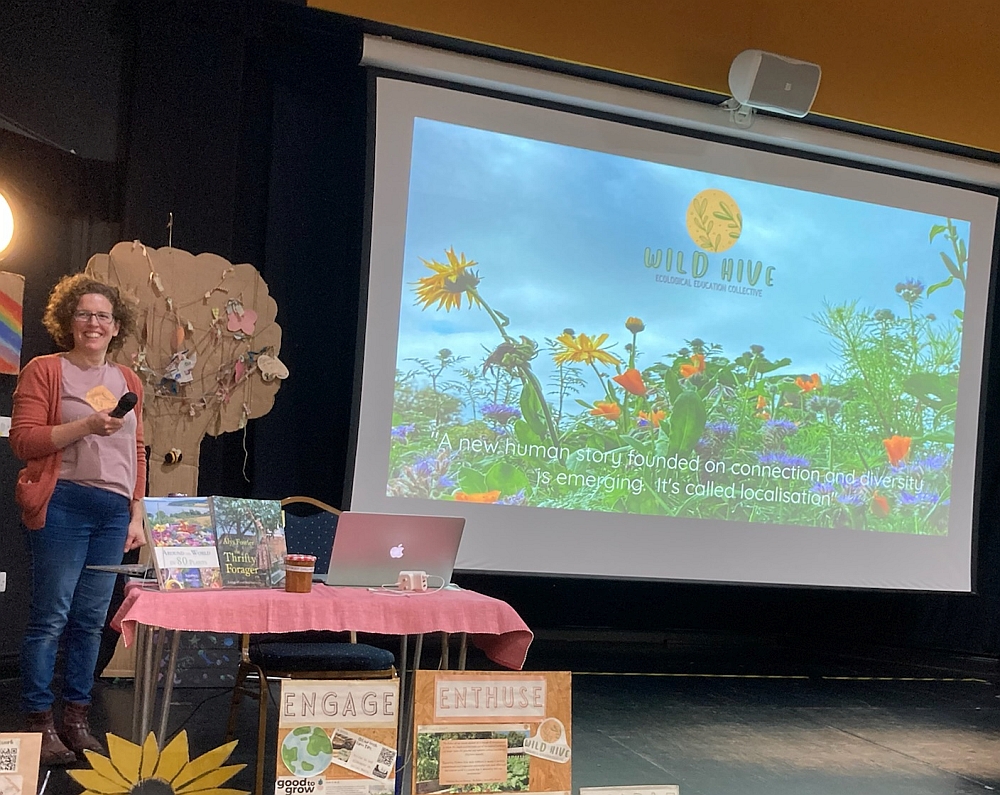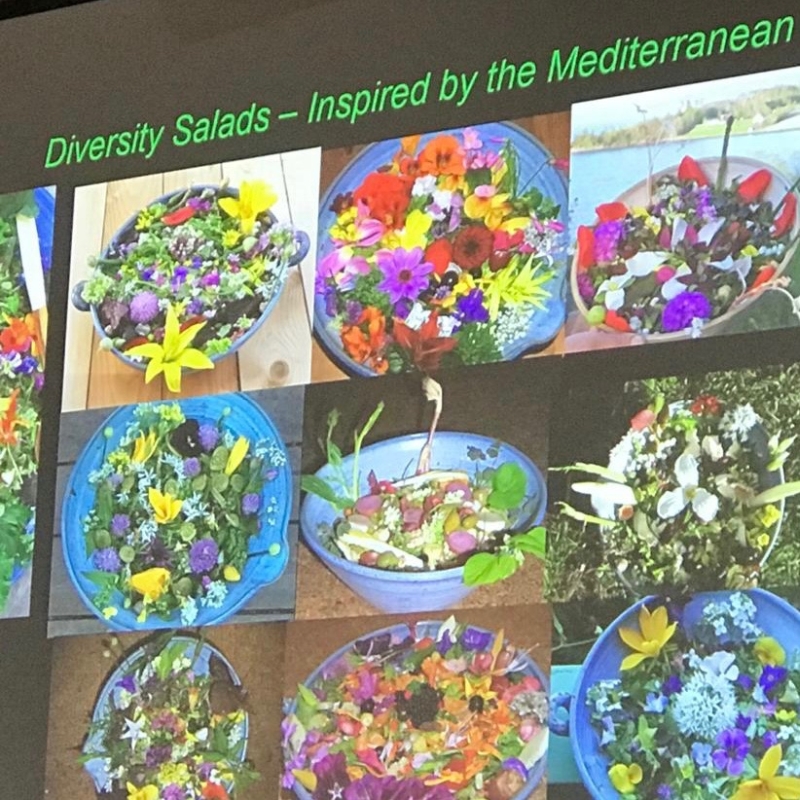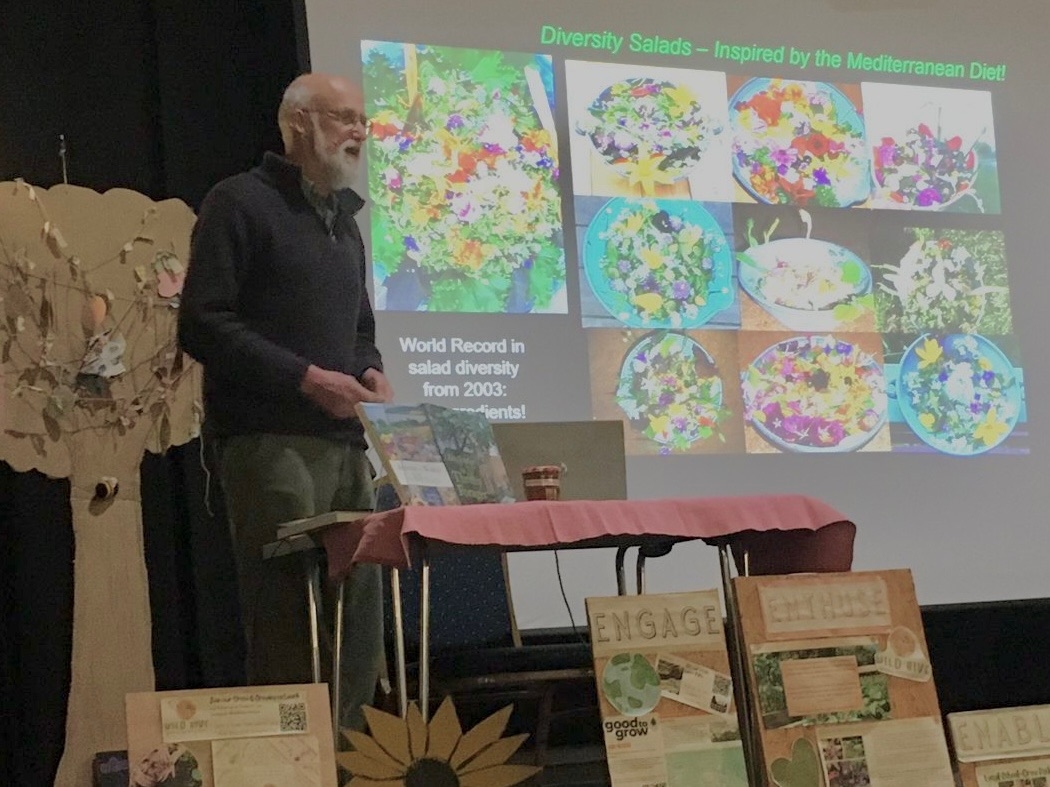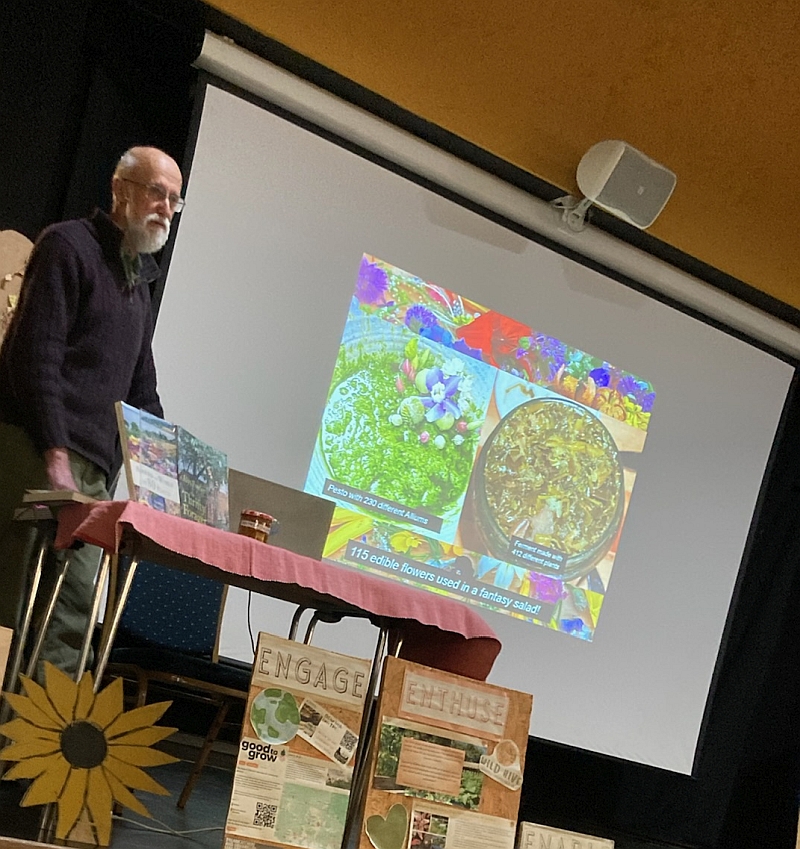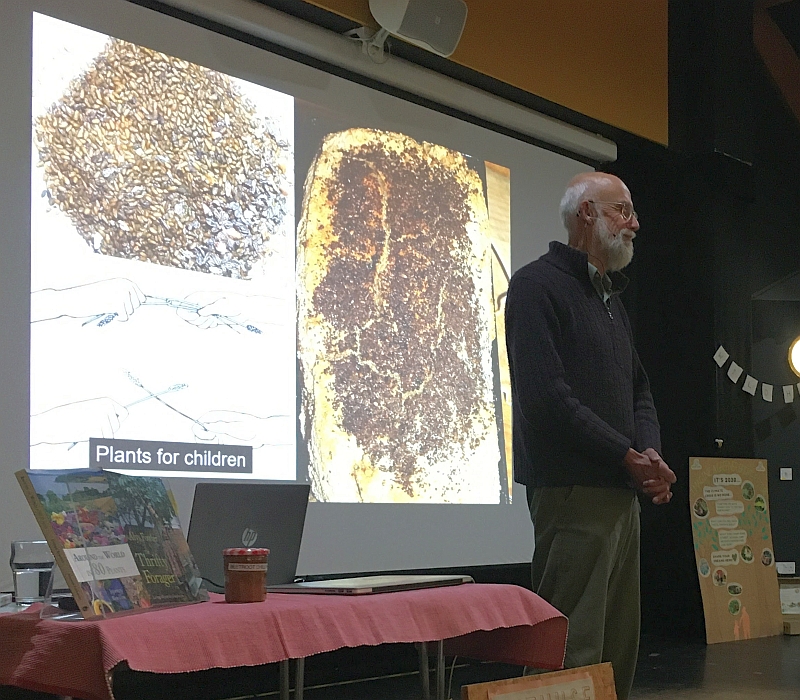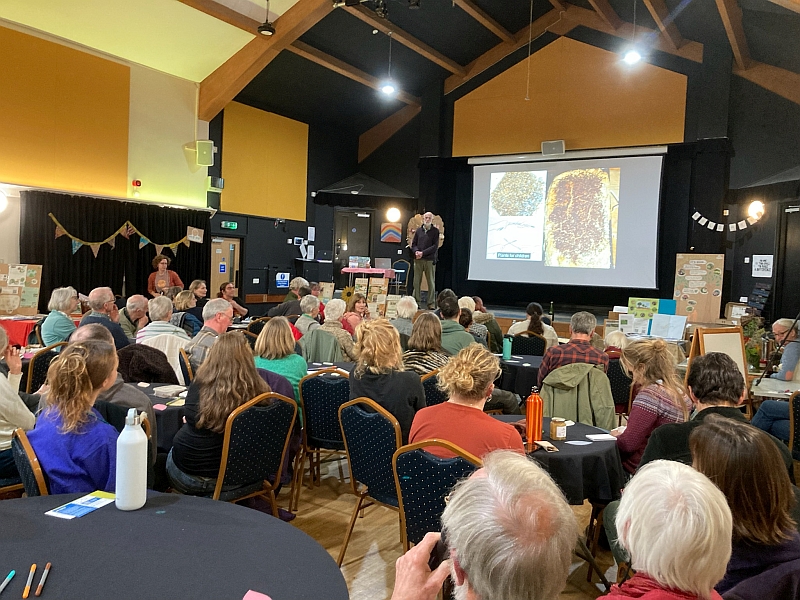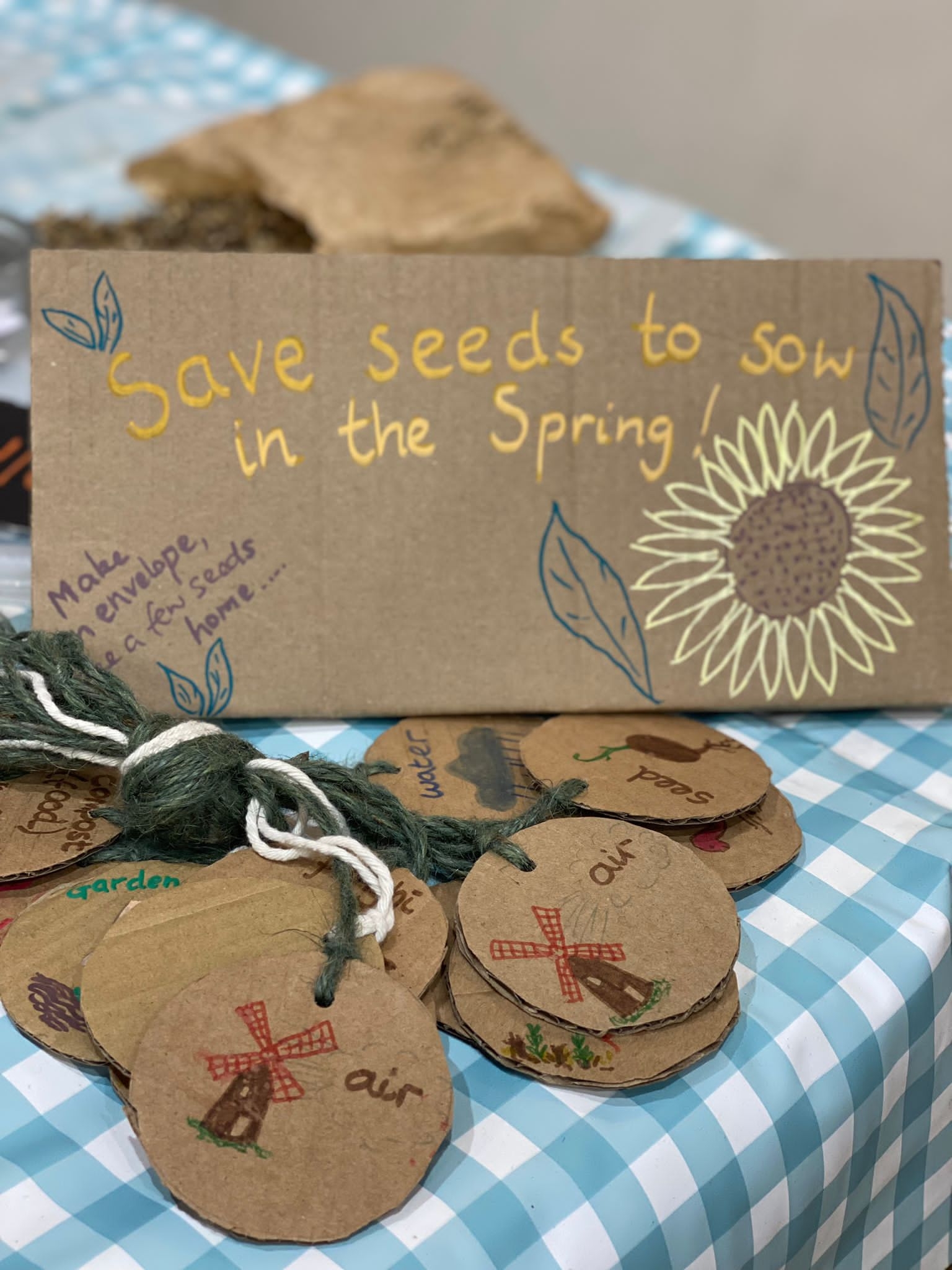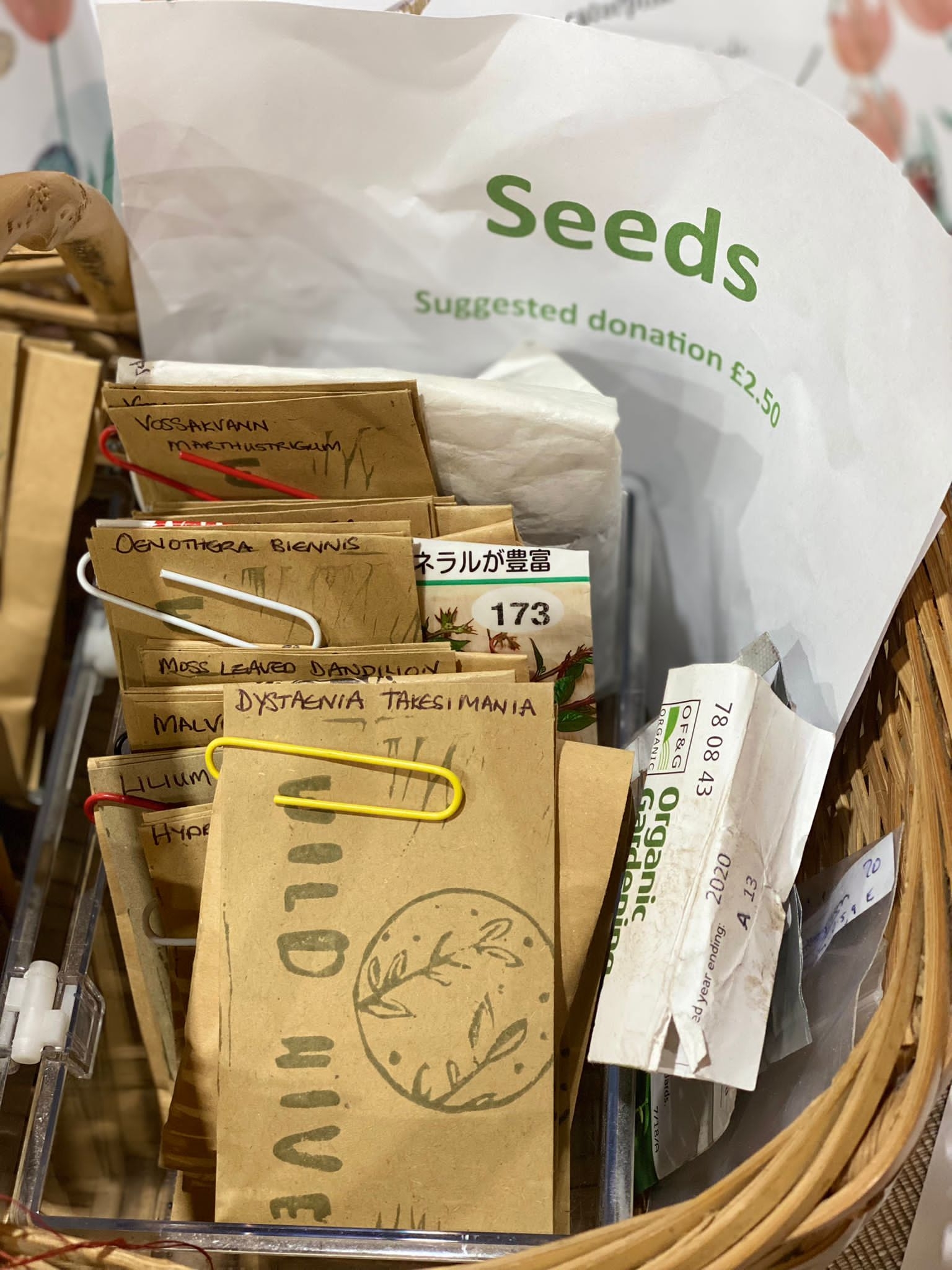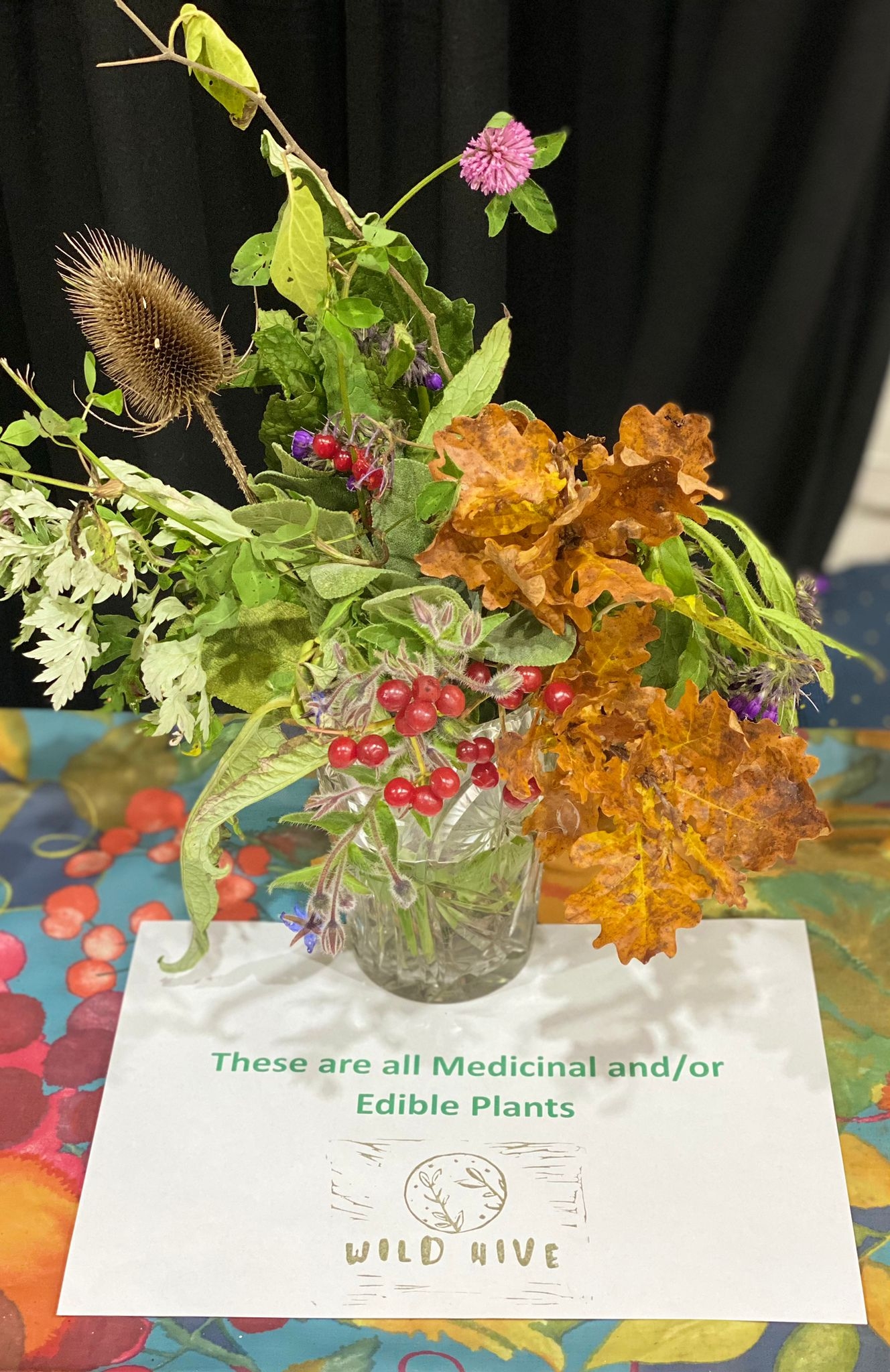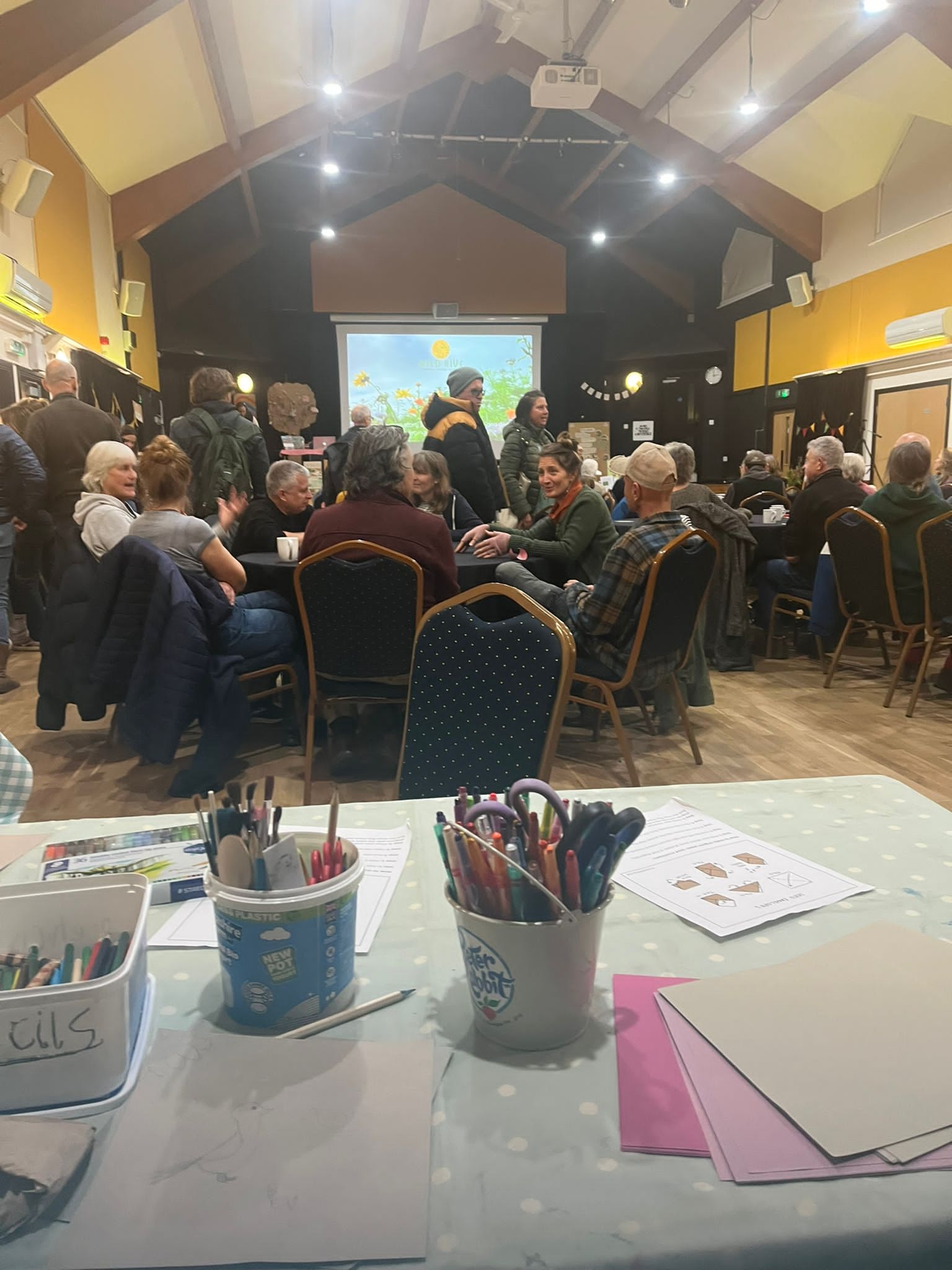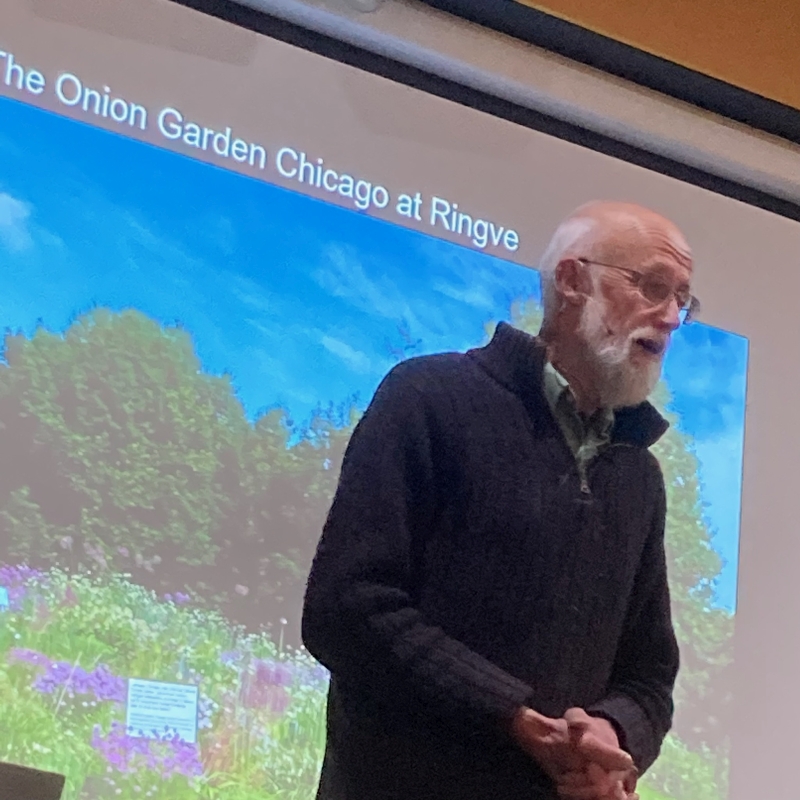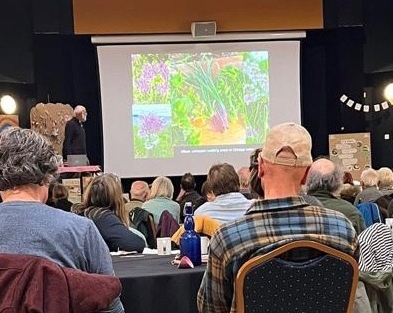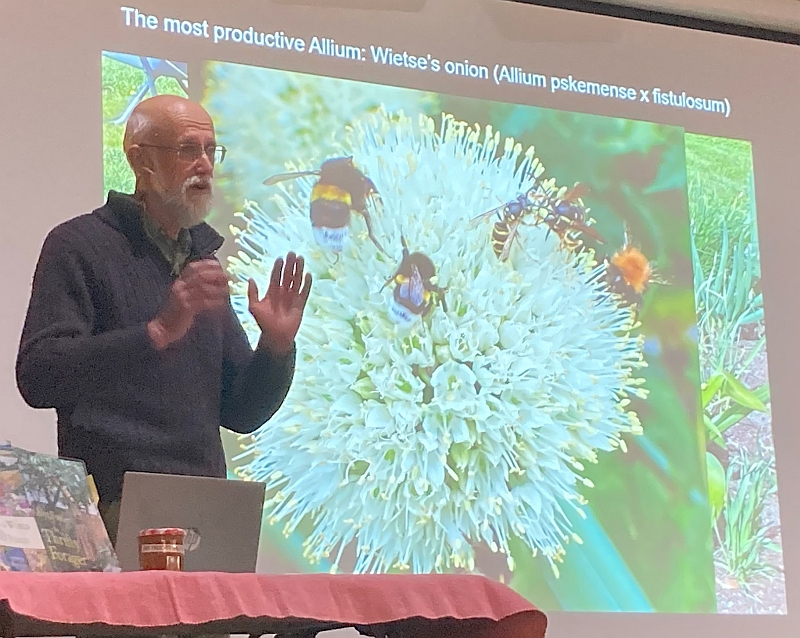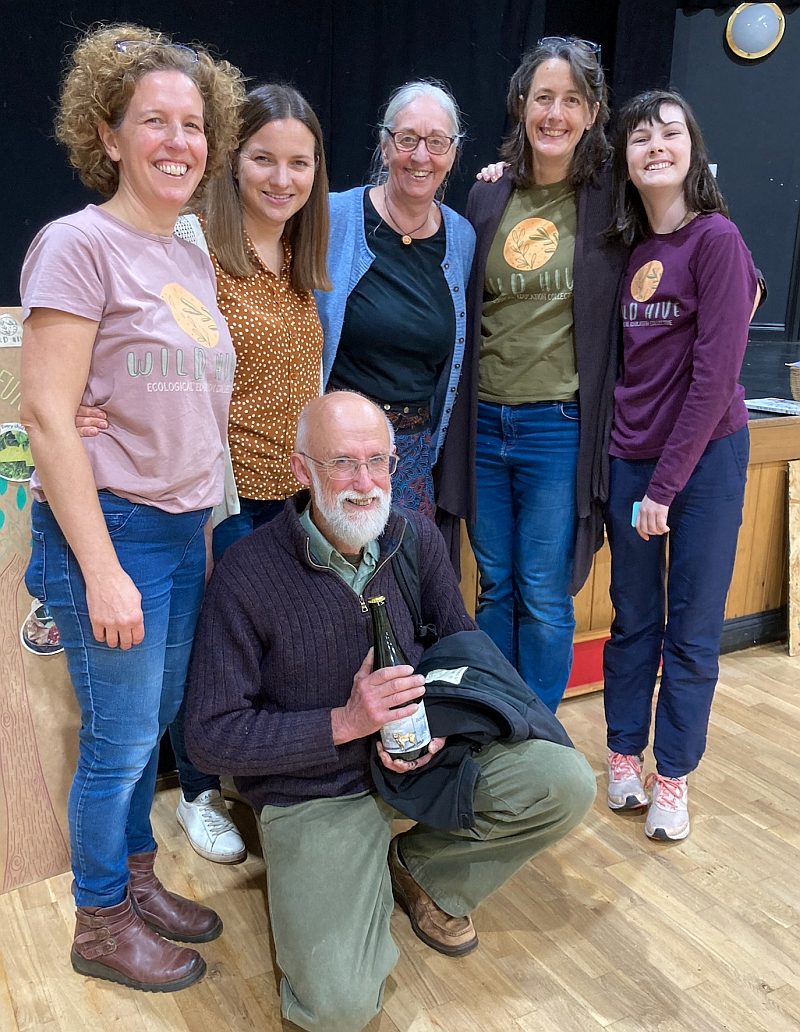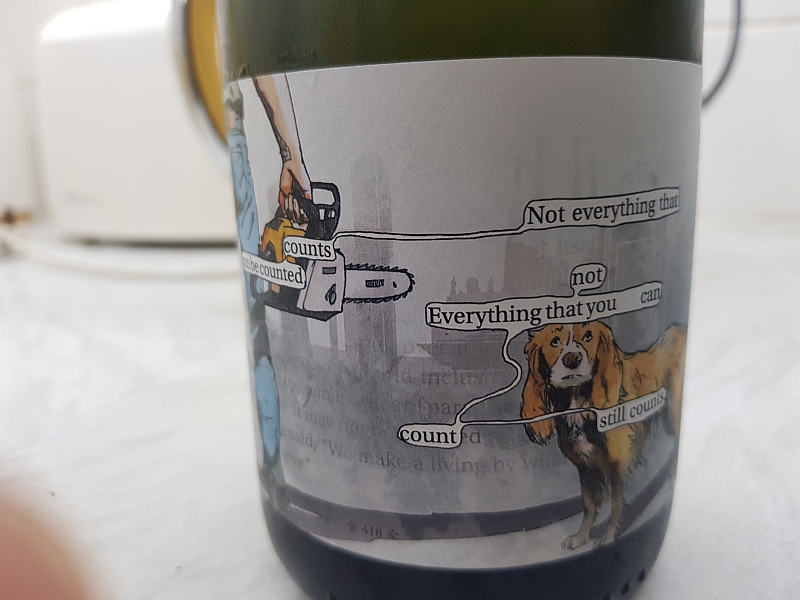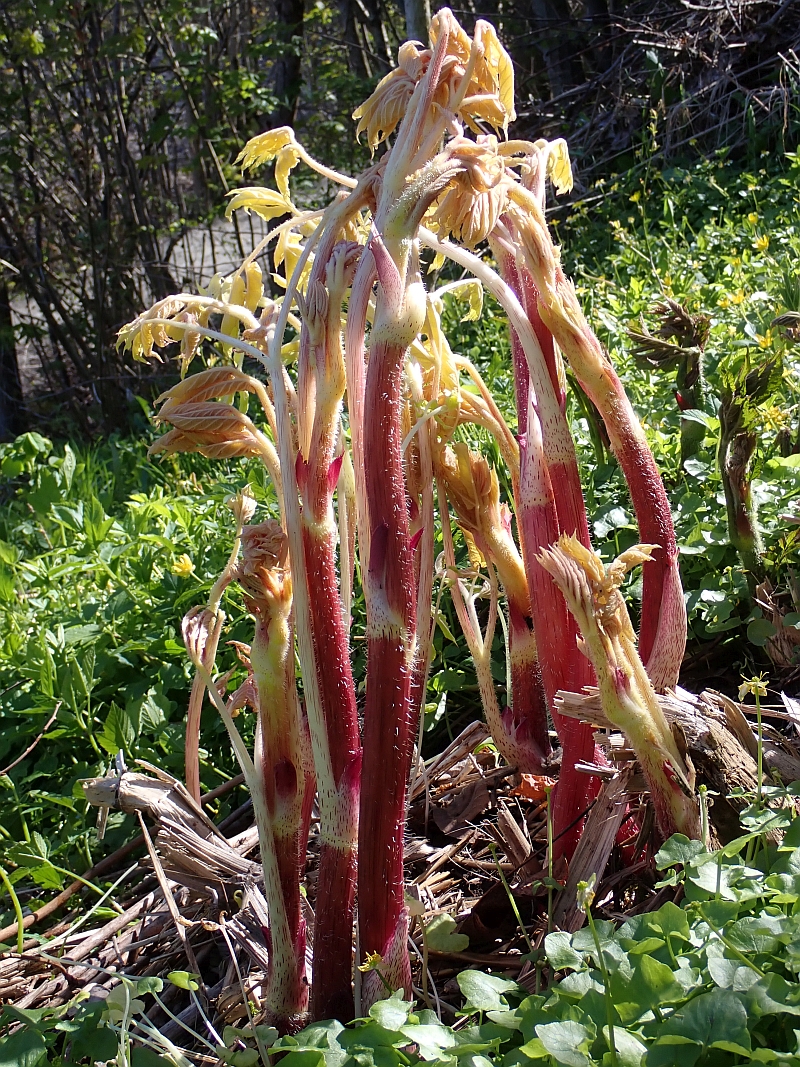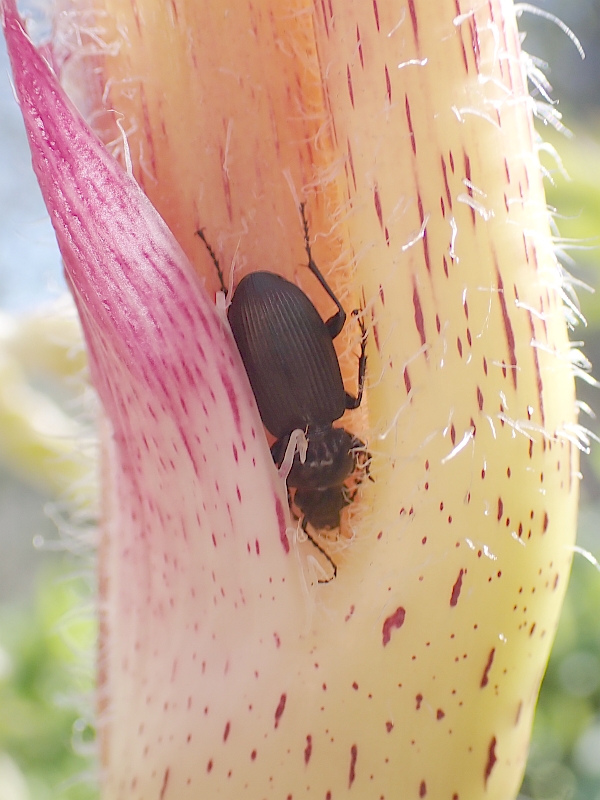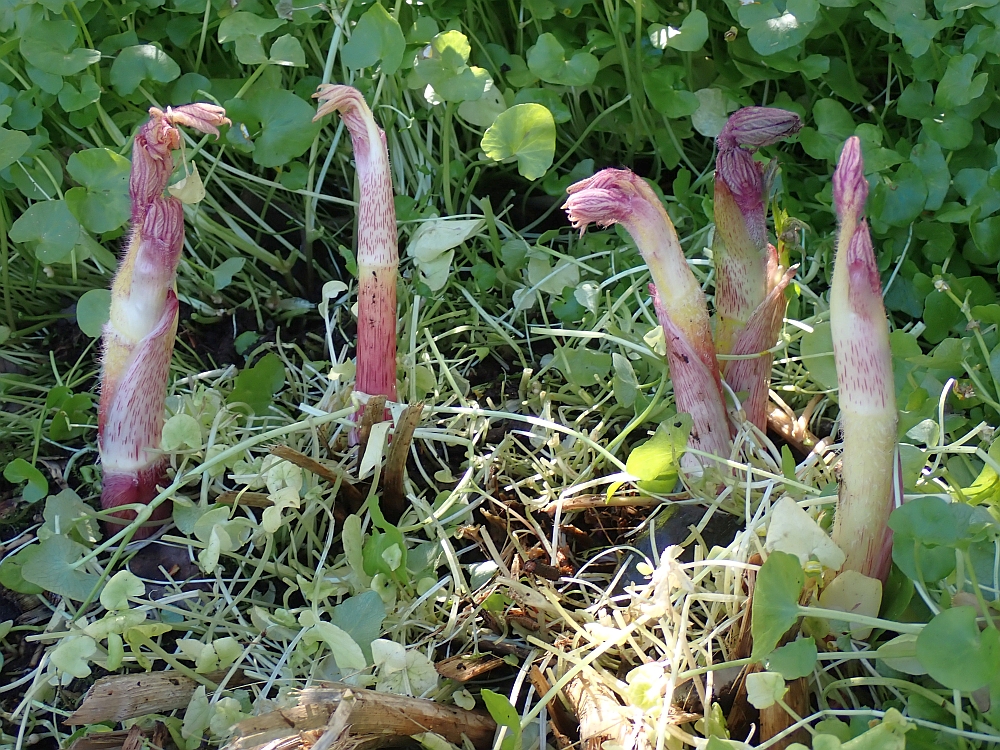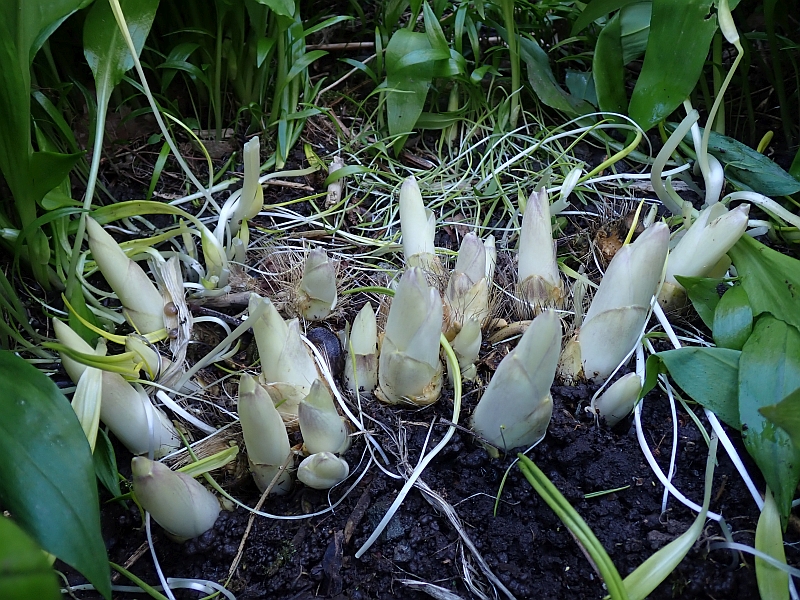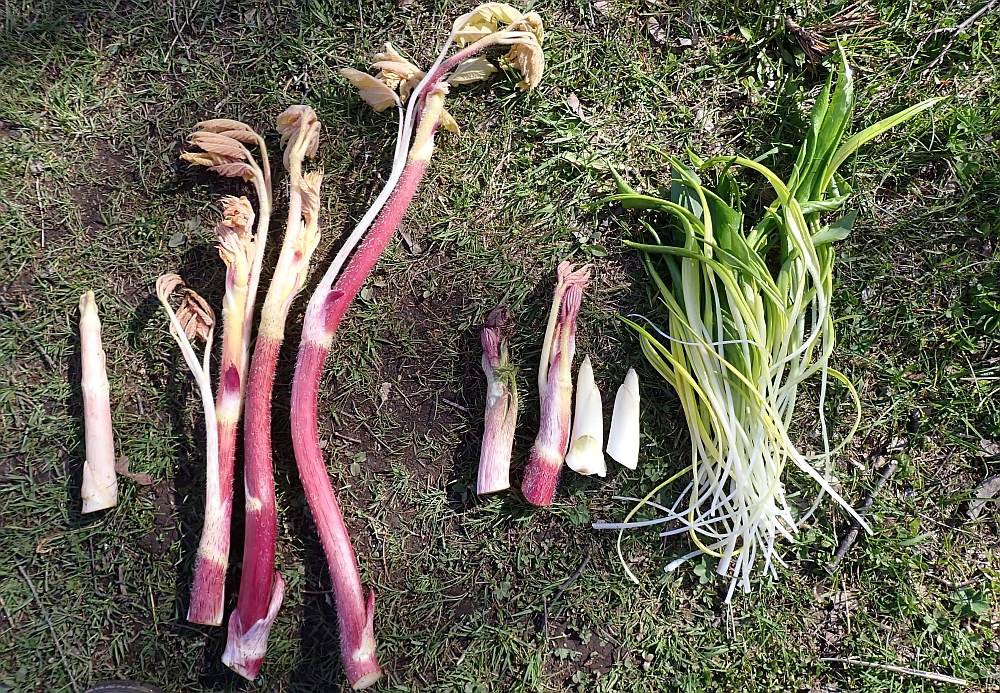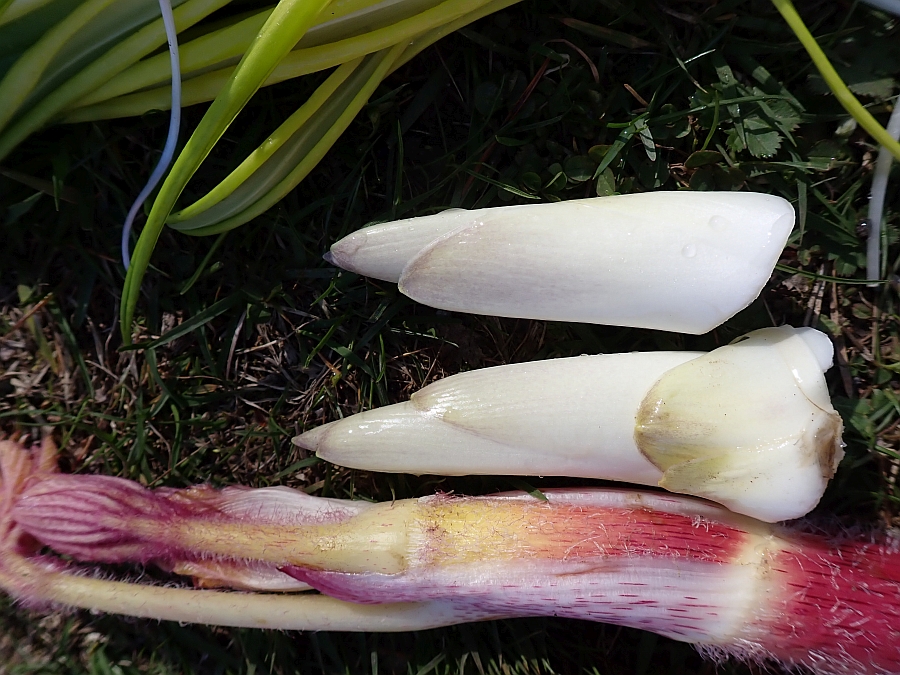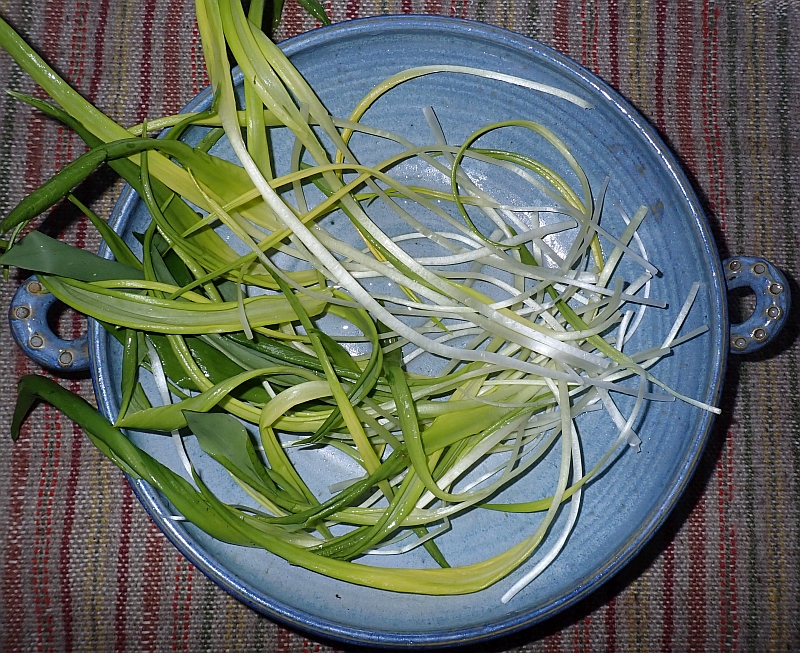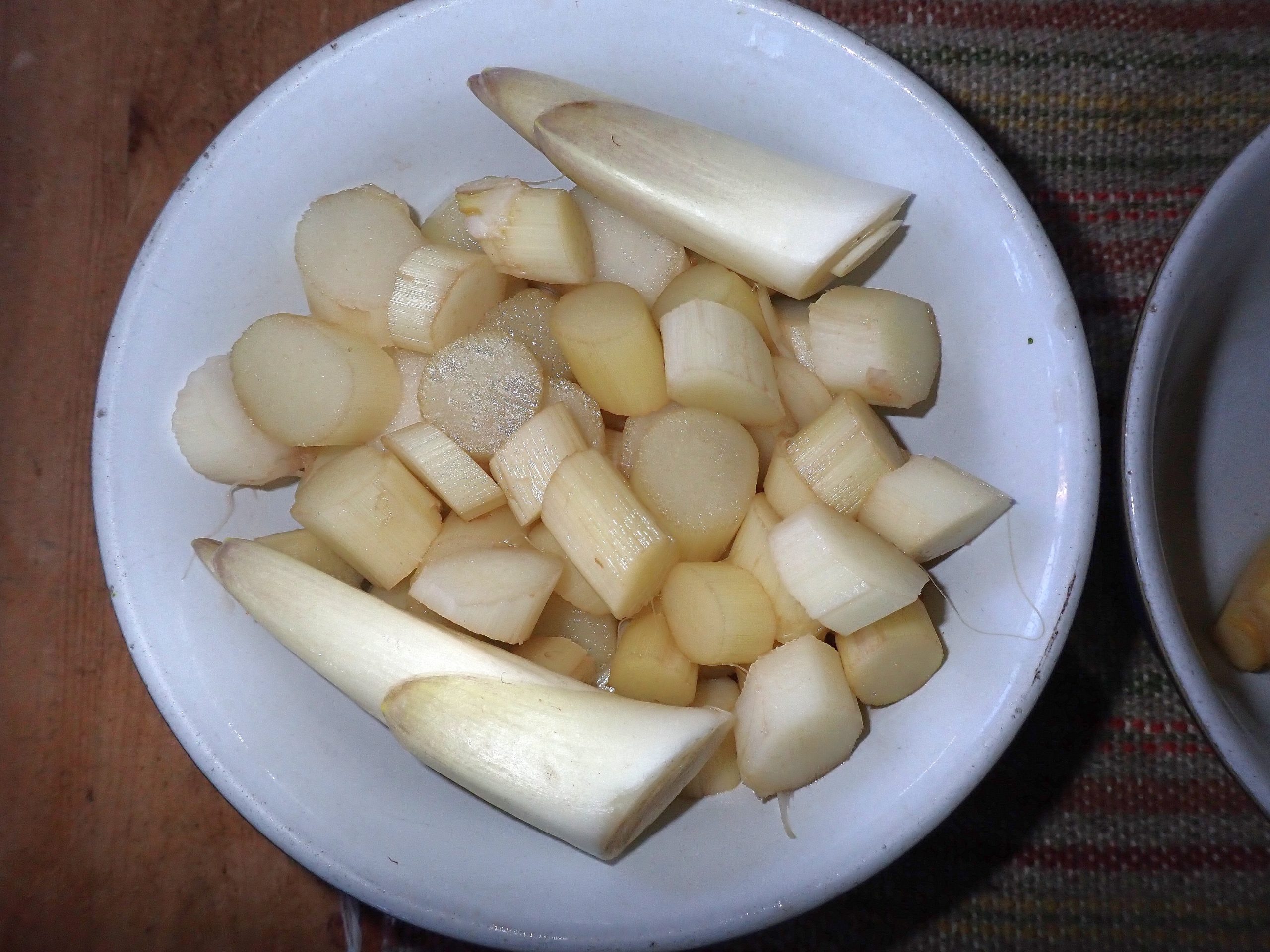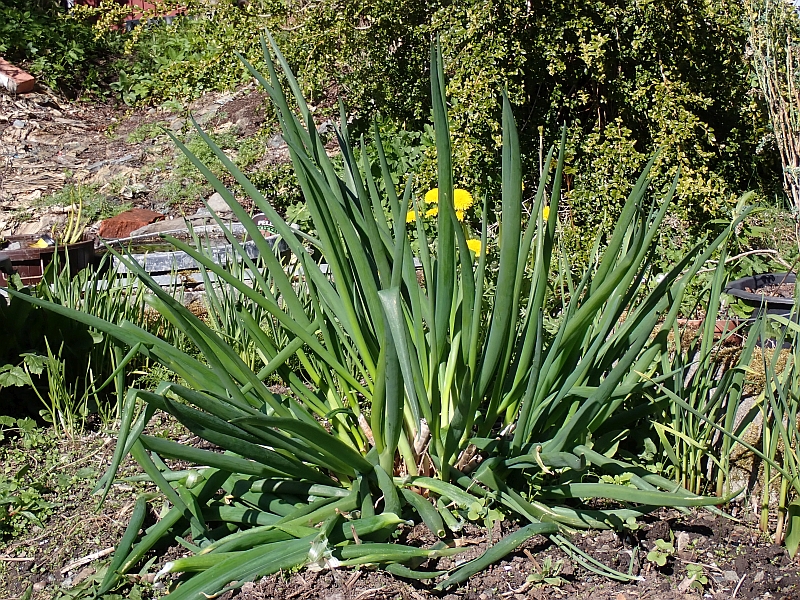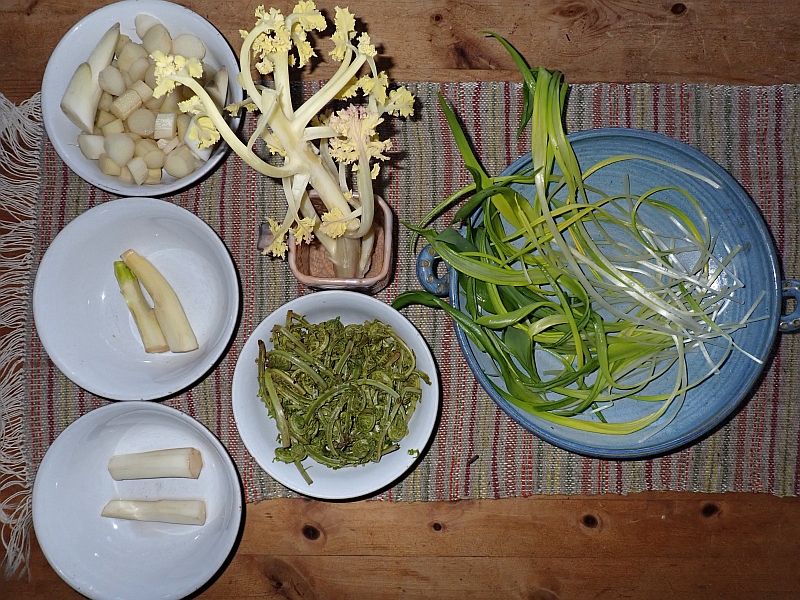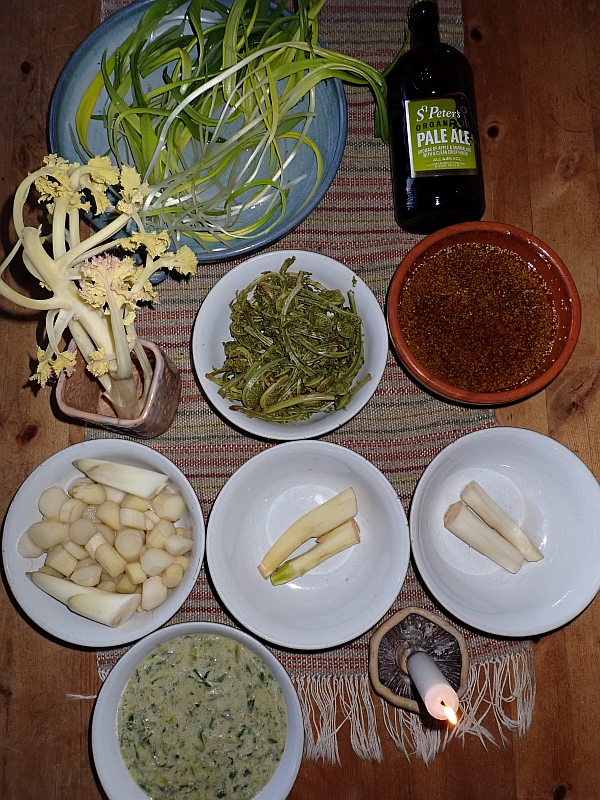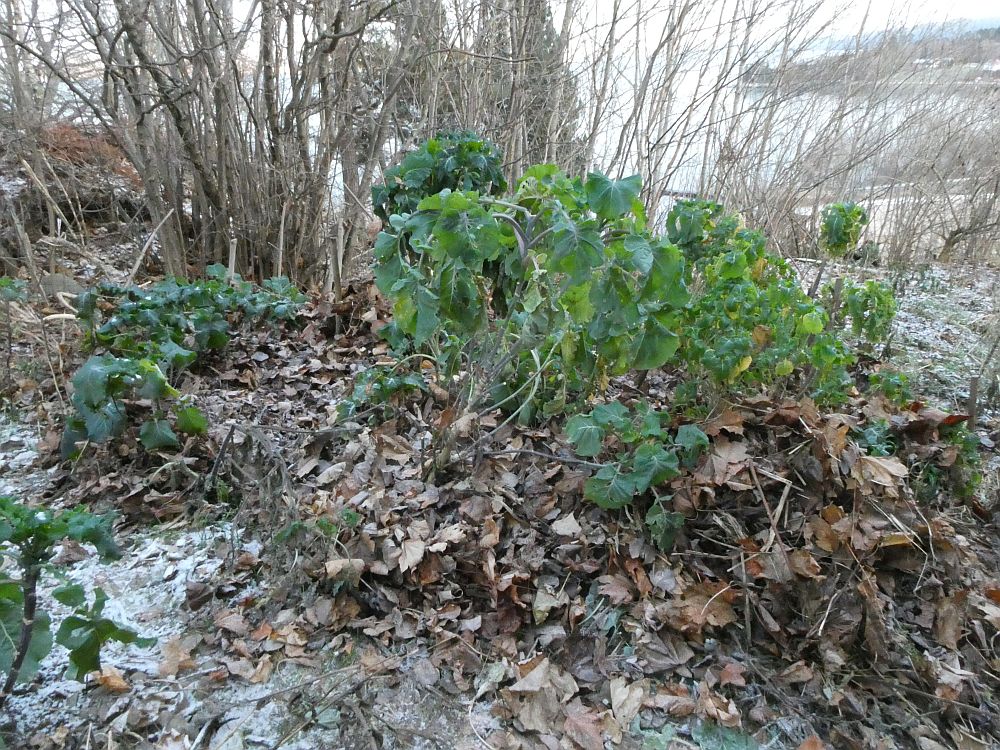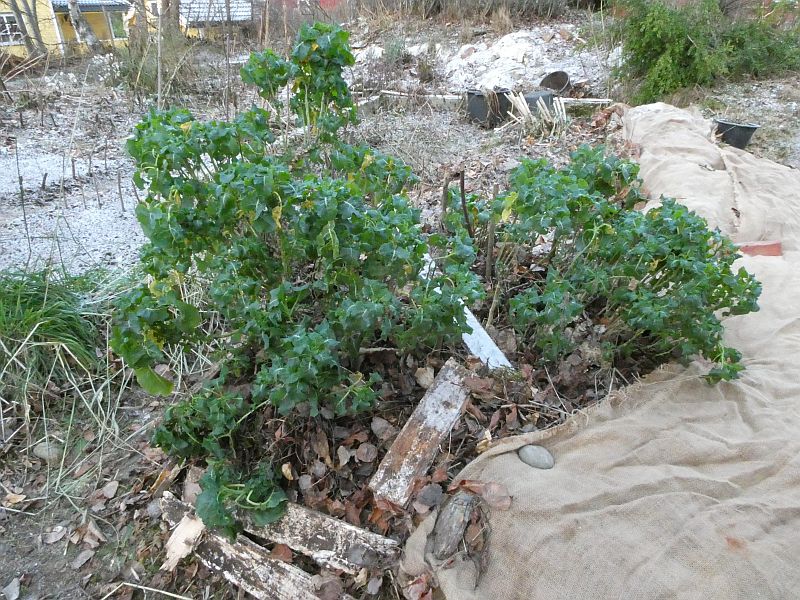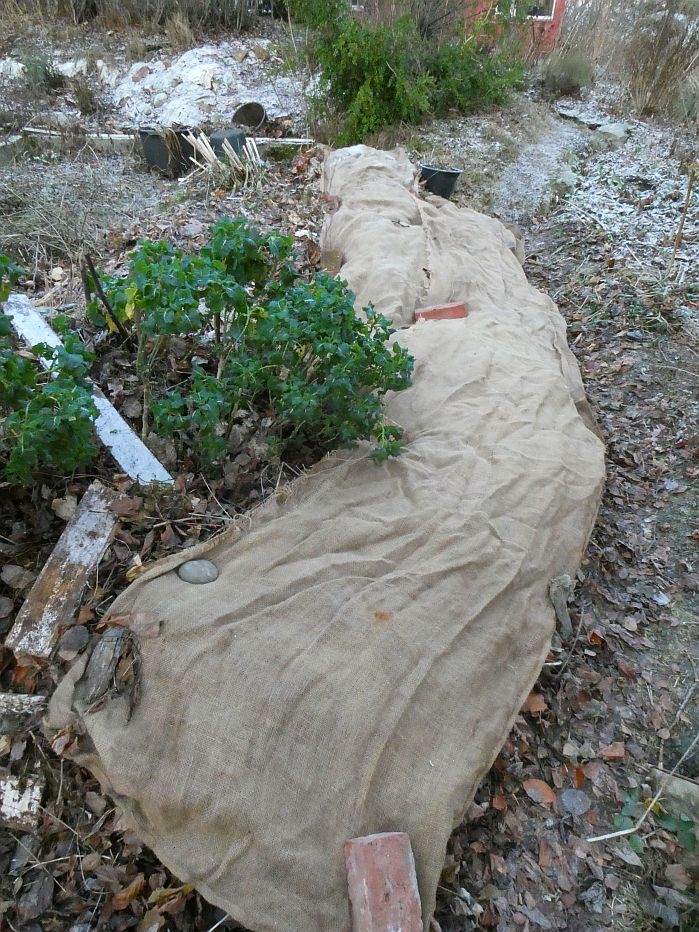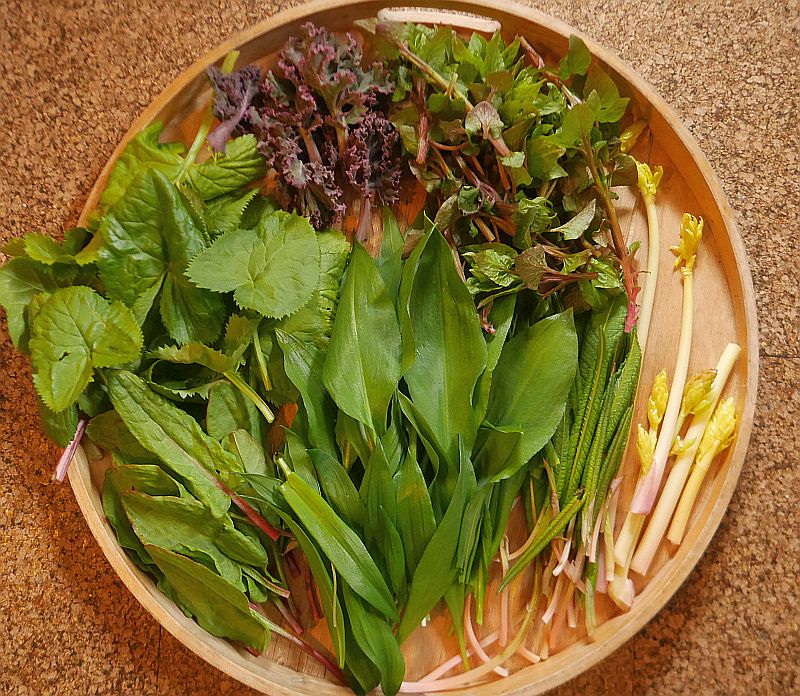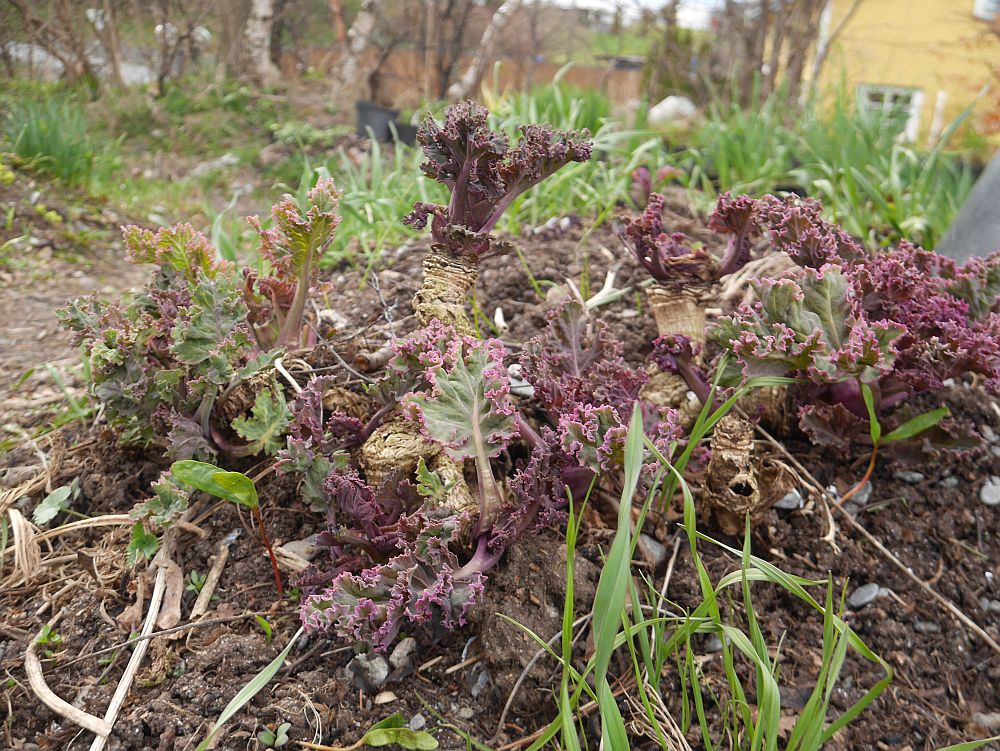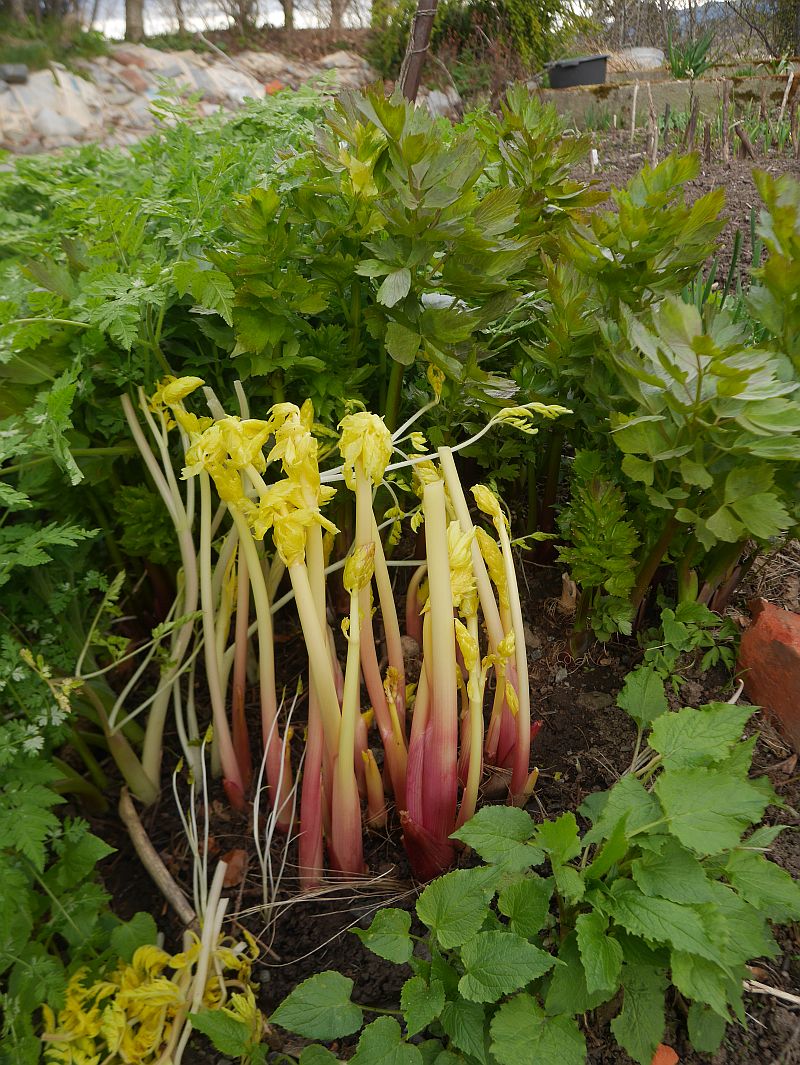On Sunday 26th May we organized a potluck party in Væres Venners Community Garden in Trondheim for the first time! It was a fantastically successful event in glorious summer weather close to 30C (and a record for May) and with 40 participants, both members of the community garden (and supporters) and KVANN Trøndelag members. The participants brought a large variety of food dishes as we had hoped! The highlight was Anders (and Barbro) Nordrum’s introductory lecture on food preparedness!
Thanks to everyone, we will be doing this again!
My contribution was naturally a salad and I had to apologise as there were only 50 plants in it ;)
The white flowers: ramsons (ramsløk), sweet cicely (Spansk kjørvel), Allium zebdanense and sea kale (strandkål).
General pictures by Dan Smith! 

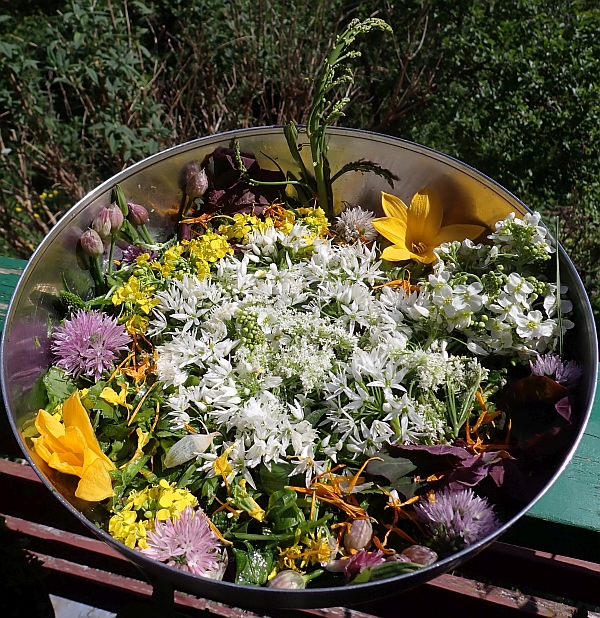
Tag Archives: Sea Kale
ARTIKLER OM FLERÅRIGE GRØNNSAKER FRA HAGETIDEND 2021
I 2021 publiserte Norsk Hagetidend en serie artikler jeg hadde skrevet om 10 av mine favoritt flerårige grønnsaker til Norsk Hagetidend. Alle artiklene kan nå bli lastet ned ved å klikke på lenkene nedenfor!
English: In 2021, I wrote a series of two page articles about my favourite perennial vegetables for Norsk Hagetidend (the magazine of the Norwegian Horticultural Society) in Norwegian. The complete series can be found below.
The plants are (scroll down to all the articles):
February 2021 Caucasian spinach / stjernemelde (Hablitzia tamnoides)
March 2021 Horseradish / pepperrot (Armoracia rusticana)
April 2021 Sea kale / strandkål (Crambe maritima)
May 2021 Nodding onion / prærieløk (Allium cernuum)
June 2021 Udo (Aralia cordata)
July 2021 St, Jansuien / sankthansløk (Allium x cornutum)
August 2021 Cherokee spinach / gjerdesolhatt (Rudbeckia laciniata)
September 2021 Hosta / bladlilje (Hosta spp.)
October 2021 Patience dock / hagesyre (Rumex patientia)
November 2021 Persian shallot / persisk sjalott (Allium stipitatum)
Wild Hive Talk at Home in Chandlers Ford: Resonating with Hampshire!
Thank you once again to all the amazing Wild Hive Collective team for organizing my talk in Chandlers Ford, my home town, on 19th November 2023. It attracted a full house of some 80 people plus helpers. See their review here: Wild Hive Collective Review
This was a special event for me being the first time I’d talked outside of Norway since Covid and dedicated to my dad (Harold G Barstow) who died last year at 97 and possibly the vegetable grower who had been at it longest in the area, here with his broad beans at 90, in a raised bed he made in his 80s, planning for old age: 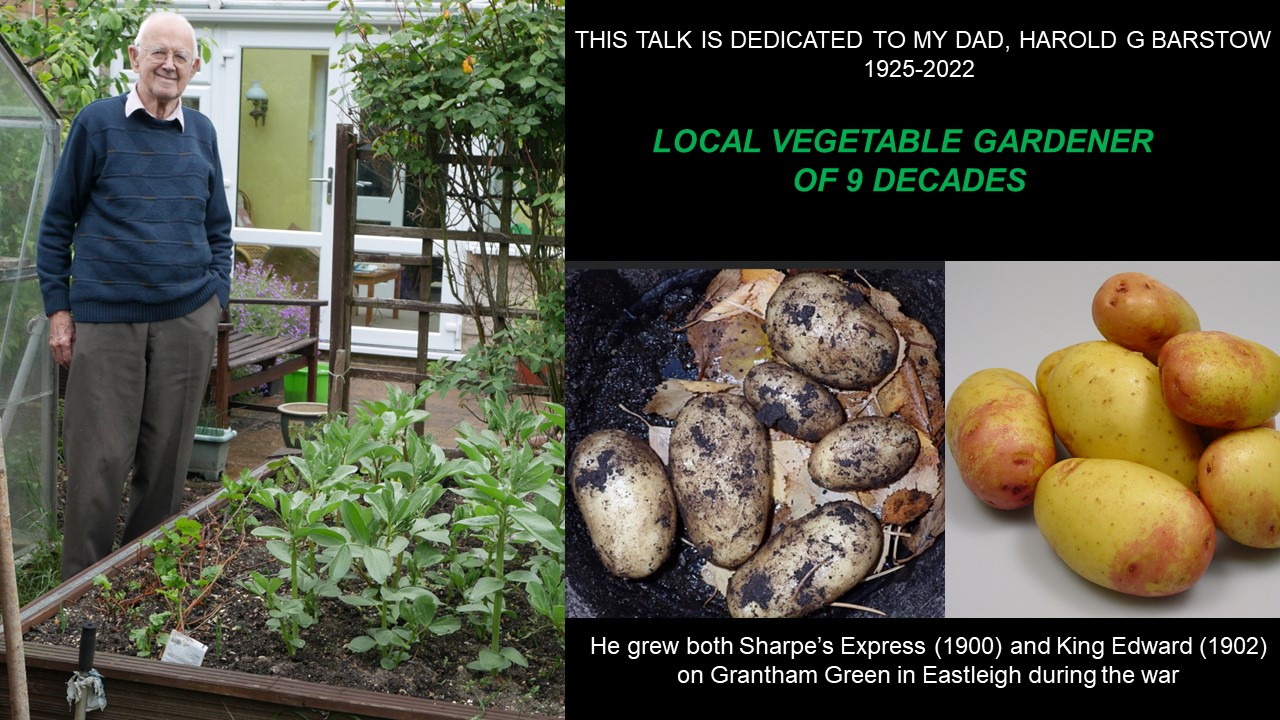 Dad had worked as a joiner/carpenter all is life (his parents couldn’t afford to give him an education and he left school early). He became an expert on Great Britain Victorian stamps (where I get my collectomanic genes from). On retirement he spent his time well, researching local history and publishing 8 or 9 books on the subject, involving learning medieval latin. He also became an artist, painting old local buildings. He wrote 4 books about the North Stoneham area where his grandfather had repaired the one-handed clock at North Stoneham (he’s pointing to him in the picture on the wall of the Cricketers Pub and he can also be seen standing with his bike in front of the church on the front of one of the books):
Dad had worked as a joiner/carpenter all is life (his parents couldn’t afford to give him an education and he left school early). He became an expert on Great Britain Victorian stamps (where I get my collectomanic genes from). On retirement he spent his time well, researching local history and publishing 8 or 9 books on the subject, involving learning medieval latin. He also became an artist, painting old local buildings. He wrote 4 books about the North Stoneham area where his grandfather had repaired the one-handed clock at North Stoneham (he’s pointing to him in the picture on the wall of the Cricketers Pub and he can also be seen standing with his bike in front of the church on the front of one of the books): …..and not forgetting my dear mum Patricia (Pat) Barstow (soon 94) who was in the audience:
…..and not forgetting my dear mum Patricia (Pat) Barstow (soon 94) who was in the audience:
The first part of my talk was all about perennial vegetables and Hampshire and all the wonderful interconnections with my family and others I’ve experienced there over the years!
In 2015, I was invited to give a two-part talk at the Walled Kitchen Gardens Network Forum at National Trust property Croome Court in Worcestershire and I discovered that two of my family were already well known and respected in that eminent group! At dinner on the first night in Pershore, it dawned on the people there that I also was the son of the “famous” North Stoneham historian and author and when it was revealed that author of the book “Garden archaeology”, Christopher Currie was my cousin, who excavated the North Stoneham site, then I was well and truly one of them!! For there is a strong link as Capability Brown (who designed Croome’s gardens) was almost certainly also responsible for North Stoneham. Several of those at dinner that night were from Hampshire and campaigning to save the North Stoneham site!! Small world and resonating with the cosmos once again…………. It was the chairwoman of the forum, Susan Campbell, one of the most knowledgeable people in the land on kitchen gardening and edible plants who had invited me to Croome, having read my book. She had thought I was Norwegian until we met. She and her husband Mike have a fantastic beachside property in Hampshire where I visited a year or so after Croome. The title of her book “Charleston Kedding: A History of Kitchen Gardening” is one of the most original book titles. Charleston Kedding is a fictional place around which the book is based, the name being an anagram for Old Kitchen Gardens!
It was the chairwoman of the forum, Susan Campbell, one of the most knowledgeable people in the land on kitchen gardening and edible plants who had invited me to Croome, having read my book. She had thought I was Norwegian until we met. She and her husband Mike have a fantastic beachside property in Hampshire where I visited a year or so after Croome. The title of her book “Charleston Kedding: A History of Kitchen Gardening” is one of the most original book titles. Charleston Kedding is a fictional place around which the book is based, the name being an anagram for Old Kitchen Gardens! 

The following year was the 300th anniversary of Capability Brown’s birth:
See more pictures from Croome here https://www.edimentals.com/blog/?page_id=2554
It was at Croome I talked about Hostas, jokeing as I did in my original article on “The Oriental Spinach” in Permaculture Magazine, about Prince Charles having the most productive forest garden in the UK as he had a national collection of large-leaved Hostas in a woodland area at Highgrove, not knowing that the Prince’s head gardener sat in front of me. I later signed a copy of my book “To HRH Prince Charles, good luck with your Hosta cuisine” asking them to pass on to the prince. This lead the following year to being invited to Highgrove to see the collection…sadly, the Prince didn’t turn up as it was his mum’s birthday….priorities!
I next introduced a good ex-pat friend in Norway, David Woodland, who had attended a talk I gave in Bergen over 10 years ago now. I had mentioned during that talk I was from Hampshire and afterwards he asked where. I said Eastleigh and he then told me he grow up only a mile or so away in Colden Common! We had been growing veg in Norway for as long as one another! David’s father was Dennis Woodland who did most of the work and took pictures for the Hillier Manual of Trees and Shrubs in the 70s. David’s family lived for some time at Jermyn’s House at the Hillier Gardens, just 6 miles from where my family have lived since the early 70s in Chandlers Ford. On the back of an interview I did with Radio Solent in Southampton soon after the book came out, I was invited to give a walk and talk at Hilliers in 2015 and the talk was in Jermyn’s House! This was the first of several walks and talks I did all over the world in botanical gardens and at Hilliers I was allowed for the first time to pick from the ornamental borders for a lunch salad! Mum and Dad attended (Dad can be seen in the background in the second picture below)!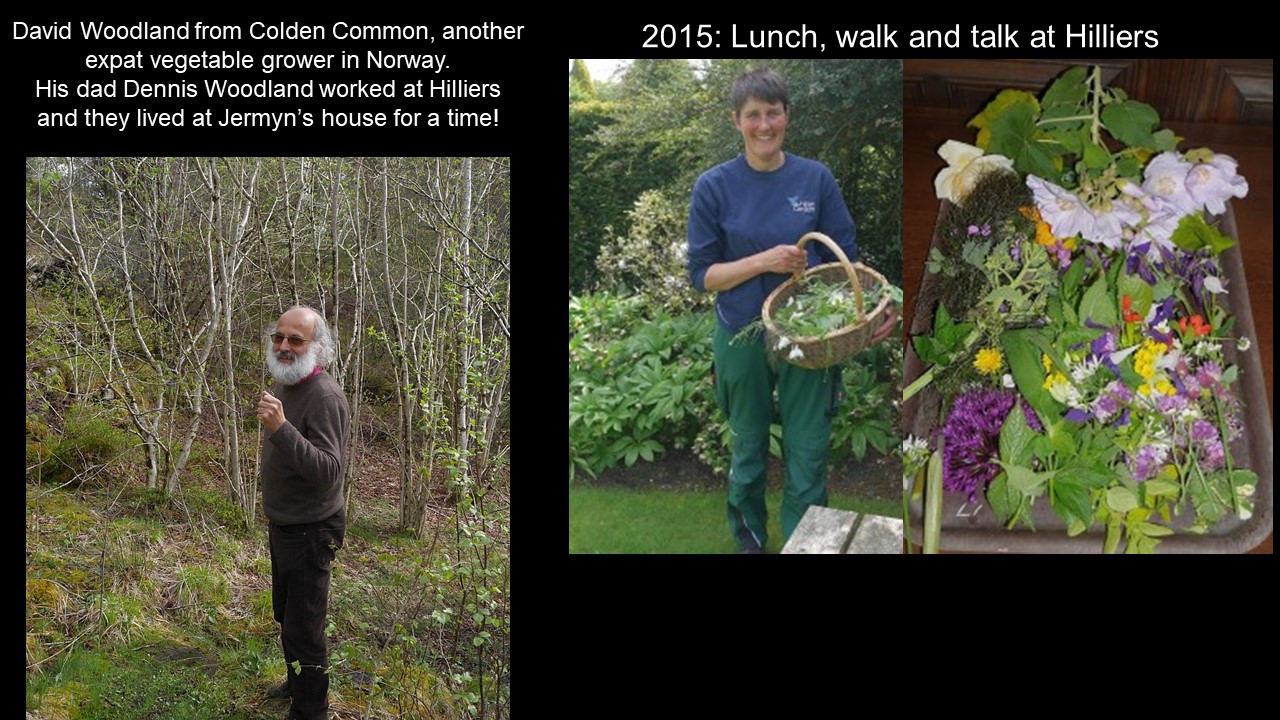
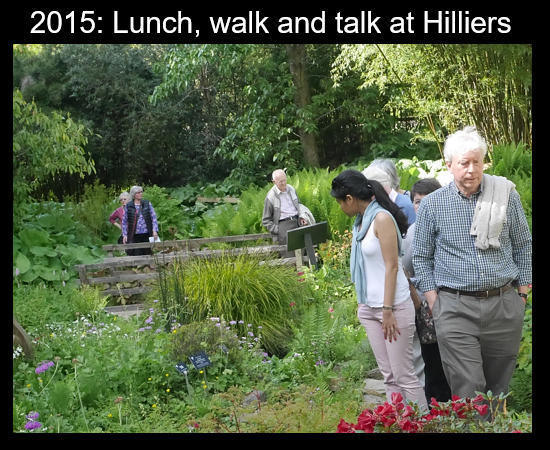 See another blog post on the Hilliers walk and talk here: https://www.edimentals.com/blog/?page_id=1281
See another blog post on the Hilliers walk and talk here: https://www.edimentals.com/blog/?page_id=1281
The next interconnection happened at that Hillier talk. As I was in Hampshire I talked about what I call the Hampshire perennial vegetable triangle where both Sea Kale (the most British of all vegetables), through William Curtis in Alton and Gilbert White in Selbourne, and watercress (Alresford) were domesticated in the 17-1800s: 
Little did I know but Sheila John, a volunteer at the Curtis Museum in Alton, was in the audience at Jermyn’s House. After the talk, Sheila approached me and asked if I would give my talk in Alton which I did a couple of years later in the Allen Gallery where, in the back garden they were planning a garden of William Curtis plants. I spent the next day in the library of the museum which had several rare books on Curtis. Sheila had also in the meantine helped me get a copy of his pamphlet on sea kale (below) from the British Museum:


….and this takes me back to garden historian Susan Campbell who I visited in 2017 at her home on the Solent, where she had a small sea kale garden next to the beach supplying sea kale to a restaurant in London (in season). At that time, she was the only one growing this wonderful vegetable for sale; see more at https://www.edimentals.com/blog/?p=10713
The same day I had visited another of the speakers at Croome, Tim Phillips who has a wonderful vineyard within a walled garden near Susan in Lymington, see https://www.edimentals.com/blog/?p=10678
I was happy to spot Tim in the audience for the Chandlers Ford talk….thanks for the bottle Tim (pictures in the gallery at the bottom)!
I can mention a few more connections to finish. In April 2008, I was with mum in the Hillier gardens and we’d stopped to admire some rather colourful purple spring shoots of a Hosta, possibly the cultivar “Patriot” (picture below). At that time I was writing my article for Permaculture Magazine on “Hosta: The Oriental Perennial Spinach” and was looking for ones with “edimental” shoots (a word I “invented” at about that time). At that moment a familiar face comes striding down the hill towards us with a group. It was well known plantsman, gardener, author and broadcaster, Roy Lancaster who has long been associated with Hilliers and I knew he lived locally in Chandlers Ford. He stopped for a chat and we talked for about 15 minutes about the edibility of Hostas and other unusual edibles Roy had come across on his travels. Below are those Hosta shoots and Roy disappearing up the path having lost the party he had been with!

 Roy’s plant exploring writing had always been an inspiration for me, having read his book A Plantsman in Nepal in the 80s! It was to be over 15 years before we should meet again as he was in the audience at my talk, invited by Wild Hive’s Lizzie Dunn who is in his family. I was hoping he would come as my friend David Woodland (above) had known him when his dad was working at Hilliers and had sent a greeting to Roy which I passed on when I saw him react to the slide of David I showed! Roy told me that they hadn’t met since he had left for Norway! Roy came up afterwards to tell me that he had enjoyed the talk and encouraged me to keep it up….wow!
Roy’s plant exploring writing had always been an inspiration for me, having read his book A Plantsman in Nepal in the 80s! It was to be over 15 years before we should meet again as he was in the audience at my talk, invited by Wild Hive’s Lizzie Dunn who is in his family. I was hoping he would come as my friend David Woodland (above) had known him when his dad was working at Hilliers and had sent a greeting to Roy which I passed on when I saw him react to the slide of David I showed! Roy told me that they hadn’t met since he had left for Norway! Roy came up afterwards to tell me that he had enjoyed the talk and encouraged me to keep it up….wow!
Incidentally, I grow one of Roy’s introductions from Nepal, a lovely form of Allium wallichii which I call “Lancaster”. It can be seen in the Onion Garden Chicago in Trondheim that I look after! Long hoverfly on Allium wallichii “Lancaster” at the Ringve Botanical Gardens
Long hoverfly on Allium wallichii “Lancaster” at the Ringve Botanical Gardens
I was also very happy to see Jen Butcher from Nottingham at the talk. She had stayed with us in Norway for a week on an RHS bursary in May and brought along two others from RHS Wisley! Another long traveller was Chris Seagon and his wife who had travelled down from Lincolnshire. They have relocated their Devon Edible Garden Nursery there!
The final connection is a special thanks to Nic Landsdowne and her husband Richard who run the venue at the Hilt in Chandlers Ford. It was also Nic, who is one of my mum’s helpers who suggested earlier in the year that I should be in touch with Wild Hive….thank you, Nic, this wouldn’t have happened without you!
…and what a lovely review of my talk event by Wild Hive (follow the link below and help them if you can, what they are doing is incredibly important!). Through the amount of work and promotion the Wild Hive – Ecological Education Collective crew put in to this, they thoroughly the fundrasing success it was!
https://www.wildhivecollective.org.uk/post/extreme-salad-man-stephen-barstow-talks-on-home-turf-in-hampshire
The talk was filmed, so will hopefully be made available at some stage!
Seed offered at the talk:
See https://www.edimentals.com/blog/?p=31661
Below are a collection of pictures taken by Wild Hive on the day (unless stated). Thanks all…and I’ll hopefully be back for more in the spring!

Tim Harland RIP
Tim kindly drove me home to my parents’ in Chandlers Ford afterwards.
See also appreciations at https://www.facebook.com/PermacultureMag
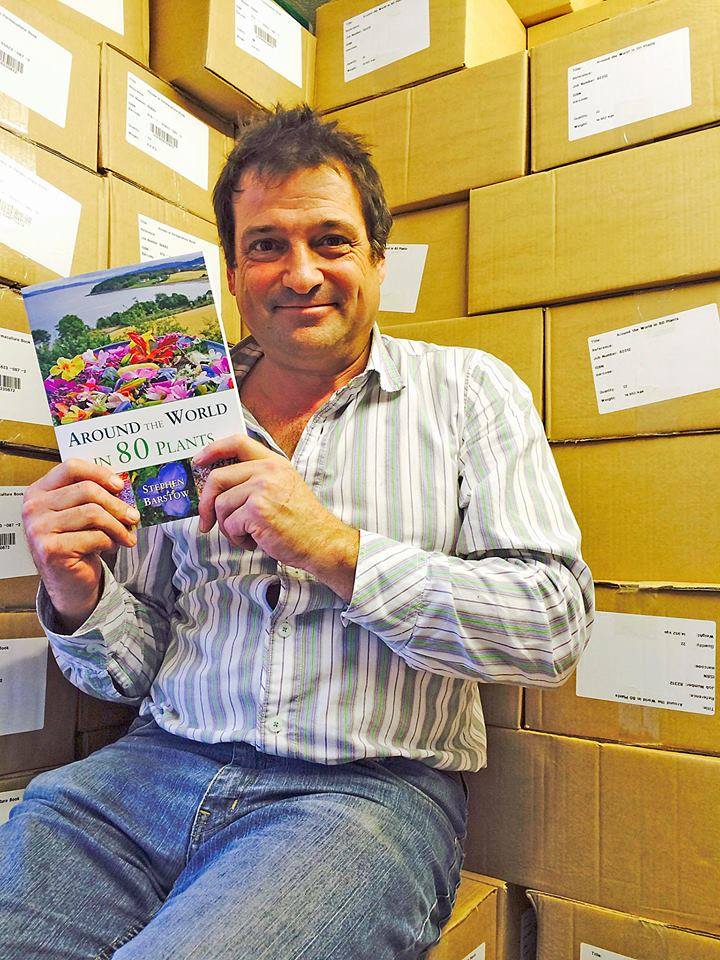
Wietse’s Onion Soup with Udos, Hosta, Ostrich Ferns, Sea Kale and Ramsons
The best of spring in one sitting. In celebration of the country Norway, we yesterday (17th May) harvested a small selection of the best blanched perennial vegetables (apart from the ostrich fern which had to be harvested or it would have been too late). This included three udo species (Aralia cordata, Aralia californica and Aralia racemosa), sea kale (Crambe maritima), Hosta “Big Daddy” together with delicious sweet blanched ramsons (Allium ursinum) . They were all eaten raw (apart from the fern which was steamed for 10 minutes) with a Japanese dipping sauce – olive oil (should have been sesame), tamari (soy sauce) and roasted sesame seeds. These accompanied an onion soup prepared with half of the leaves from one plant of Wietses Onion, a vigorous hybrid of Allium pskemense and Allium fistulosum!
It doesn’t get much better than this! More information with the pictures:
Fasciated dandelion- udo- sea kale salad
Not something I can make very often as I don’t find fasciated dandelions very often! A simple salad was put together, made fascinating with a fasciated dandelion.
The blanched udo (Aralia cordata) was ready: I harvested some blanched sea kale (Crambe maritima) too and I found a fasciated dandelion to decorate the salad
I harvested some blanched sea kale (Crambe maritima) too and I found a fasciated dandelion to decorate the salad
 The udo was peeled
The udo was peeled 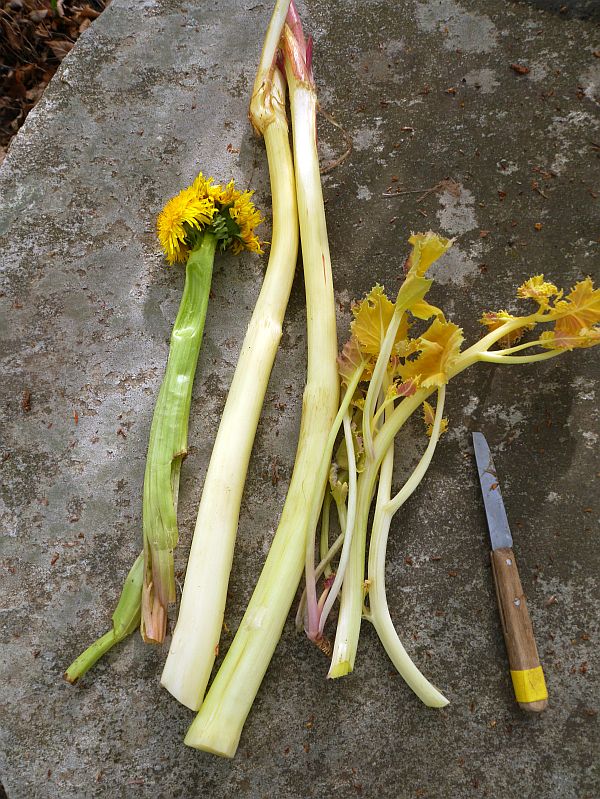
…and the salad was put together with the fasciated dandelion flower stem cut into strips and mixed in with a sesame oil – soya sauce dressing:
Unintentional presents
Yesterday was my birthday and the best presents were all unintended as birthday presents:
1. Allium victorialis from a large stand that has naturalised from a farm garden in Nordland county, Norway to be offered to various members of KVANN (Norwegian Seed Savers) when I get time (From Inger Elvebakk, who also took the picture):
2. A new sea kale / strandkål (Crambe maritima) accession from a KVANN member, from a wild population
3. Decorah Posten took over a month to get here, but it arrived too on my birthday (see https://en.wikipedia.org/wiki/Decorah_Posten); more about this another time!
Winter protecting my perennial kales
Kales (Brassica oleracea) have a reputation for being really hardy, but in reality there are many perennial vegetables that are far more hardy. I mean, kales don’t really make much effort to protect themselves, remaining green all winter and in a normal winter here all my kales would die. However, in areas with mild winters, they are useful as they can be harvested all winter outside. Most perennials die back to the roots and reshoot in spring. Sea kale (Crambe maritima) is one example of this and is thus easier to overwinter. A dream of the perennial kale breeder is a variety that is capable of reshooting from the roots or at least from low down on the plant.
The last couple of winters have been very mild with hardly any frost all winter and almost all my kales have survived (the exception being less hardy Tree collards from California). This winter has been significantly colder and the air temperature has only been above zero C since New Year for a short period. I was prepared for this and spread a thick layer of leaves around the roots to stop the soil freezing around the roots with either jute, spruce branches or planks over to stop the leaves blowing away in winter storms.
In addition, I always take cuttings which I overwinter in a cold room in the house. Almost 100% of cuttings are successful.
Norwegian quinoa and swamp greens medley
13th June 2020 perennial greens were stir-fried and served with quinoa and served with Allium ursinum flowers.
Allium validum (swamp or Pacific onion) with flower shoot
Saxifraga pensylvanica (swamp saxifrage)
Gunnera tinctoria
Asparagus officinalis (asparges)
Crambe maritima (sea kale / strandkål broccolis)
Perennial kale “Walsall Allotments” (flerårig kål)
Campanula latifolia (giant bellflower / storklokke)
Aster macrophyllus (big-leaf aster)
flowering shoots of various Russian Rumex acetosa cultivars (sorrel / engsyre)
The greens were stir-fried with chili and garlic and served with Norwegian organic quinoa with ramsons (ramsløk) flowers:


Pizza greens 1st May 2020
Presenting yesterdays greens used on a veggie 100% whole grain barley/spelt/rye sourdough pizza were:
Hablitzia tamnoides (Caucasian spinach /stjernemelde) (eaten now every day since the beginning of March and there’s more to harvest now than at any time since I started!)
Crambe maritima (sea kale / strandkål)
Allium ursinum (ramsons / ramsløk)
Levisticum officinale (lovage / løpstikke) (I call blanched lovage “spring celery” as it’s not that much stronger than celery…and much easier to grow than celery organically)
Ligularia fischeri (Gomchwi; Fischer’s Ligularia / Koreansk nøkketunge) (King of the Sannamul: see http://www.edimentals.com/blog/?page_id=3114)
Rumex patientia (Patience dock / Hagesyre)
Bistorta officinalis (Bistort / Ormerot)












